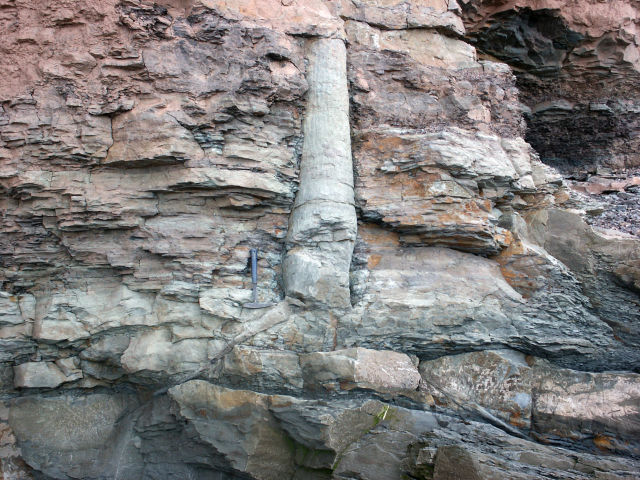
It made for a neat story:
Question: Why did so much of the world’s coal form during the geologic period we now call the Carboniferous?
Answer: Large tree-like plants evolved before fungi evolved the ability to break down the fibrous lignin that helped give the plants structure. With nothing to make them decay, their remains were free to pile up and yield thick coal deposits.
It’s a neat story, but, a new study led by Stanford’s Matthew Nelsen argues, it’s not true.
While coal deposits formed both before and after the Carboniferous, this period provided the mother lode. It occurred a bit over 300 million years ago and was a funky time that saw relatives of club mosses grow to the size of trees while insects also reached comparatively gigantic proportions due to the higher-than-modern oxygen concentration.
The reason all that oxygen was present, by the way, is the vast burial of organic material before it could be eaten by oxygen-respiring organisms. And while oxygen rose, atmospheric CO2 fell, eventually leading to glacial conditions. It was a massive carbon-cycle experiment that mirrored our current one but with carbon moving in the opposite direction, from the atmosphere into the ground, where it formed the coal we’re now burning into atmospheric CO2.
Lignin is a major component of the woody tissue that modern tree trunks are made of. It is tough for most organisms to eat, except for the white rot fungus that lives on dead trees. Estimates for the arrival of this fungus on the evolutionary scene place it just after the Carboniferous. But the authors of this new paper argue that there’s significant uncertainty in that estimate. And since fossil evidence of fungus is hard to come by, it’s possible white rot was around in the Carboniferous. What’s more, they point out that white rot doesn’t have a perfect biochemical monopoly on the lignin-munching business; some other organisms might have evolved that skill earlier on.
The researchers actually offer up a back-of-the-envelope calculation that makes the “lignin-just-evolved-before-lignin-eaters” hypothesis for all that coal seem pretty problematic. If global plant growth was even 25 percent of what it is now, lignin carbon would have piled up at a rate of about three gigatonnes per year—which could add up to the world’s total coal reserves in perhaps a thousand years. At the same time, atmospheric CO2 would have dropped to zero in under a million years.
All the Carboniferous world’s lignin couldn’t have made its way into coal, and lignin isn’t even the only type of organic matter in Carboniferous-age coals. At least some of it must have decayed.
The paper also notes that where there are bits of fairly well-preserved plant tissue, there is some evidence that the decay process worked the same as it does today. There is preserved tissue showing visible signs of partial decay. Above-ground tissue is harder to find than root material, for example, which happens because a lack of oxygen in the wet ground prevents decay by oxygen-respiring organisms. And rather than lignin-rich remains, it’s the lignin-poor parts of those trees that seem to be preserved the best, the researchers say.
Stepping back from the magnifying lens, big-picture patterns seem to be telling a different story, too. Some Carboniferous coals include lots of material from ancestors of conifers, which contained more lignin than their giant club moss relatives, making these coals particularly lignin-rich. And at one point, these Carboniferous ecosystems shifted away from woody plants almost entirely, making very lignin-poor coals. If the coal were lignin-dependent, the rates of deposition would be very different. But looking across North America, there is no real difference in how much coal was forming at the time of those transitions.
So if missing fungus can’t explain the abundance of Carboniferous coals, what can? The researchers propose a more conventional explanation. The formation of coal requires two steps. First, you need a swampy environment where peat can accumulate in low-oxygen conditions that ward off decay. Second, you need to bury the whole mess quite deeply, allowing pressure and temperature to turn your peat into coal.
During the Carboniferous, the Pangaea super-continent was coming together. And in a tropical swath along the equator, a mountain range (now the Appalachians) was being pushed up by continental collision. On either side of that growing mountain range, the crust bowed downward a bit as a result. Those ever-deepening bedrock buckets were positioned right beneath soggy tropical wetland regions. The end result was lots of deeply buried peat.
There was one other time in North American history with significant coal formation, and that was a period bracketing the mass extinction of the dinosaurs. Then, too, there was mountain-building (this time the Rockies) with a neighboring basin, and hot, wet climate conditions.
Describing the neat story we’ve been using to explain the abundance of Carboniferous coal, the researchers write, “Such geobiological hypotheses sometimes persist based largely on the strength of their novelty, without sufficient predictive testing.” Having tested this hypothesis and found it lacking, they conclude that “the Carboniferous-Permian peak and subsequent decline in coal production most likely reflects a unique combination of tectonics and climate with the particular details of the evolution of plant and fungal community composition bearing no direct relevance.”
PNAS, 2016. DOI: 10.1073/pnas.1517943113 (About DOIs).
reader comments
75